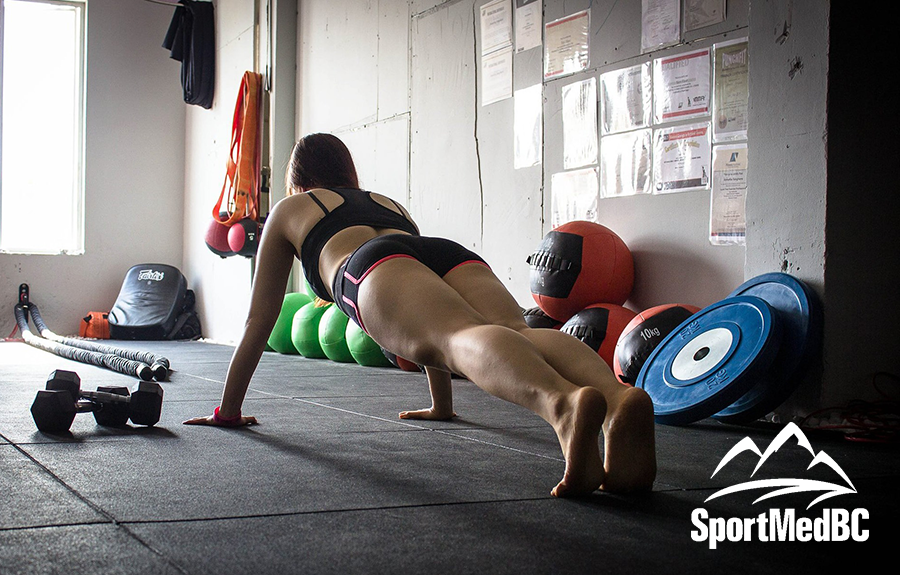Core Strength and Conditional Training
Apr 27, 2017

Remember that commercial that showed an athlete doing a thousand plus sit-ups to train for a sport? The boxer is dripping with sweat from doing sit-up after sit-up. Strengthening the core used to be considered thousands of sit-ups and curl-ups. We now know that these exercises are not effective to train you for performance sport. In fact, they actually could hurt you physically and not help you perform your sport the best you can.
The “core” is the trunk area of your body that transfers power during movement. It is very important to have a strong core for any athletic event. This area is made up of your inside and outside muscles and make up lumbopelvic stability and flexibility (lumbopelvic is just the area where your back connects to your hips). With a strong core, sport specific skills are done easier and do not cause injury.
The inside muscles are also called your local stabilizing muscles. You cannot feel them work with your hands because they are right next to your spine. They are considered postural muscles and they are built for endurance as they are working all the time. These muscles anticipate when you are going to move and prepare your spine to absorb or transfer the impact. You can maintain your center of gravity and not lose your balance because these muscles act before you have to react.
The outside muscles are also called your global movement muscles. You can feel them work with your hands because they are your abdominals and back muscles (middle and lower). They are considered strength muscles because they are used to perform actions. These muscles allow you to lift your arm to throw a baseball or lift your leg to kick a soccer ball.
Other muscles that help with stabilizing the core are the hip muscles that attach the spine to the hip bone (pelvis). With all movement, both upper and lower, your body uses a lumbopelvic rhythm to perform the exercise. When you throw that baseball and kick that soccer ball your pelvis rotates. With strong lumbopelvic stability you transfer power from the ground to move your arms or legs without wasting energy.
The term ‘core training’ has become an all-purpose label for exercise that addresses some aspect of lumbopelvic stability. The spine experiences both compression and tearing away forces during upper and lower body movement. The lumbopelvic muscles help keep the spine centered (neutral) to resist outside forces from different types of loading. This type of stability includes both core stability and functional exercises. Remember, no one muscle is more important than the other so you want to think overall training. Include a variety of exercises to make sure that all areas of stability are worked at one time or another.
The following goals of spinal stabilization increase the ability of your lumbopelvic muscles to stabilize so you can make sure the spine stays centered. By conditioning key muscles you increase the lower back’s ability to handle unexpected movements. You also want to restore muscle size, strength, endurance, and re-establish coordinated muscle activity to prevent an injury from happening. When you are successful with all these goals you decrease the amount of pain you are experiencing from spinal instability.
When considering how you train as an athlete there is a difference between training for performance and training for rehabilitation. Rehabilitation training is low impact core training that is low intensity and done in a quite atmosphere. The goal of this type of training is to develop control of your inside muscles. During these exercises you need to consciously breathe so you teach these muscles to remain active during all movements. When you breathe deeply you also partially relax the outside muscles (abdominal muscles you can feel) so your inside muscles (spine and abdomen muscles you cannot feel) can be properly activated.
Dynamic core training teaches postural control, whole-body balance, and proprioception that are also heavily used in controlling lumbopelvic stability. Proprioception is when you know what your body and its parts are doing (i.e. when you close your eyes and lift your arm you know that you are doing it without seeing it). Dynamic stabilization uses activation of your muscles, and the tension on them at rest, and includes exercises that challenge these elements on unstable surfaces. Standing on a wobble board or doing sit-ups on a swiss ball are good examples.
Training the hip muscles for a single leg stability movement is also good for lumbopelvic stability. This trains you to kick the soccer ball more easily because you can spend more time on the opposite leg. Be sure to avoid twisting with exercises until your core is strong because it could create harmful tearing away forces on your spine. Twisting should always come from the lumbopelvic complex, not just the spine. When you throw the baseball this complex rotates and creates more power.
Injuries can be from lumbopelvic instability when your standing (static) stability and the patterns that your muscles move are ineffective. This instability affects the entire lower body chain of movements because the outside muscles try to compensate and lose their real function. Some muscles become tight while others are looser than ideal.
Flexibility training is another way to help prevent injuries. Both lumbopelvic and lower body flexibility have positive effects on core strength. Athletes will experience low back pain because the hip is not flexible and the spine has to do all the work. When your tight hip cannot rotate the lower body, or help with bending the spine forward, the spine is forced to do these actions on its own. You often end up bending and twisting in places where you should not. Increasing flexibility helps develop power in your hips so your spine does not have to compensate for lack of lumbopelvic movement.
Other things to look for are tightness in the gluteal and hamstring muscles which is common in athletes with lumbopelvic instability. You can also get stiff sitting on the bench waiting to play. Include ballistic (dynamic) type stretches before you get back in the game but prepare your body ahead of time by including static stretches in your training program so returning to play is faster. These stretches are done after practice or competition, best after a hot shower.
Your inside and outside muscles provide stability for your lumbopelvic complex. Building both endurance and strength in these muscles evenly creates a sound base for your core. If there is uneven training or injury has occurred than the balance of movement is thrown off. Maintaining consistent training of flexibility, strength, endurance, and muscle control prevents this imbalance and more worth all the sweat.
